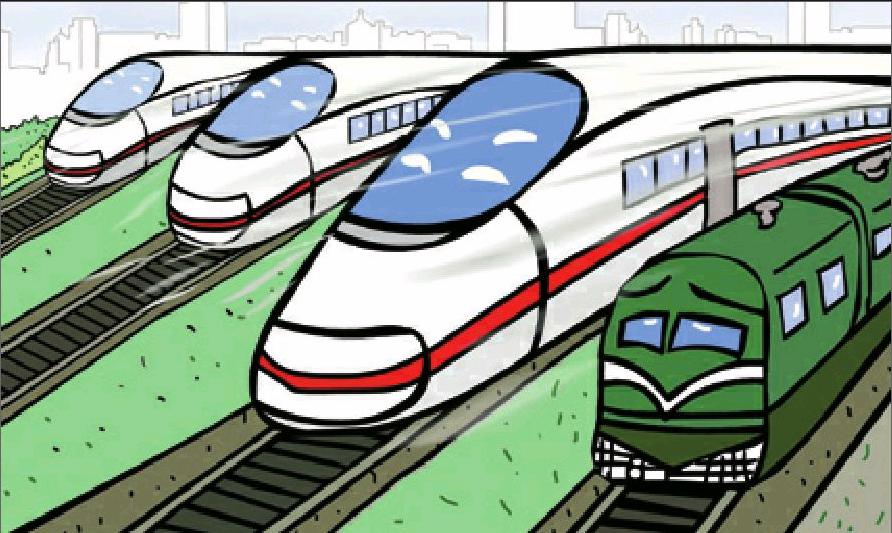Has the Whistle Blown for China’s Traditional Trains?
2014-08-27

Chinas railway system has recently adopted a new operation plan, in which high-speed bullet trains account for more than half of all passenger trains in use across the country. As China enters the high-speed transportation era, many welcome the replacement of its time-worn green trains, which are infamous for their slow speeds and lack of air conditioning.
However, not everyone is excited about this news. Though bullet trains far outpace their older counterparts in terms of speeds, comfort and punctuality and are even able to compete with airlines for distances under 1,000 km, at present, the higher ticket price is unaffordable for low-income earners. With the development of Chinas railway system, bullet trains will cover an expanding area, including remote towns and villages. yet for those who live there, the disappearance of cheaper green trains will undoubtedly reduce their means of and access to travel, forcing them to pay more to ride the same rails.
Is this modernization of Chinas trains for the better, or should widely accessible mass transportation be the goal of the nations railway system?
Social progress
Chu Jie (www.chnrailway.com): The countrys green trains are known for their distinctively slow pace, outdated and worn facilities, poor air quality and uncomfortable spaces. Due to the lack of air conditioning, they are extremely uncomfortable in Chinas hot summers. Additionally, such trains cannot operate at the same high speeds as their newer counterparts, and thus take much longer to cover the same distance. This leaves passengers feeling exhausted after a simple train journey. With the turn toward technological advancement, passengers will see a vast improvement in the train travel environment as a whole—at an increased price. But despite this heightened cost, trains are still more affordable than many other modes of transportation.
The safety of a train journey is of paramount importance, particularly for riders on long-distance routes running through different provinces. From this perspective, its apparent that green trains have been in service for too long to make them reliable, with many parts in the trains getting worn down and rusted. When given the choice between riding in these train cars or in the belly of a sleek bullet train, who would choose the former?
As Chinese peoples living conditions improve, they begin to pay more attention to safety, convenience and speeds, and old trains can no longer meet most passengers demands. To shorten travel time and improve the travel environment, its high time Chinas railway system moved in the direction of development.endprint
Wu Ce & Fen Ni (www.china.com.cn): For decades, with green trains as the only available long-distance option, people reluctantly have grown used to all of the inconveniences endured while riding them. Now with a variety of choices, like trains with air-conditioning and lightning-fast bullet trains, who would hesitate to pay the higher price for a more pleasant ride? This is the biggest reason behind phasing out green trains: All of the discomforts and inconveniences are no longer necessary.
With a clean and comfortable carriage environment and fast speeds, riding on a modern train will make returning to their green counterparts almost unbearable. yet some argue that the disappearance of old trains will reduce traveling options for low-income earners. The so-called “low-income earners” mainly refers to migrant workers. However, as the number of air-conditioned trains and bullet trains increases, green trains will be needed only temporarily during crowded holidays. During the annual Spring Festival, or Chinese Lunar New year, for example, when many migrant workers return to their hometowns for the celebration, there is a sharp rise in the number of passengers on the countrys trains. When tickets for these modern trains become unavailable, people will have no other choice but to ride green ones. These passengers will not necessarily be low-income earners; the sheer number of people traveling simply necessitates extra space.
Thus, concerns over ticket prices for lowincome earners are not a solid enough reason to keep green trains in operation. As society moves forward, outdated things unsuitable for the modern world should retreat into history.
Public service
ye Suxun (www.xinhuanet.com): The traditional railway system is a kind of public welfare, with its cheap tickets and broad networks across the country, even to very remote areas. So when expensive high-speed rail cars have replaced all the mid- and long-distance green trains, low-income earners, who depend heavily on affordable trains for travel, are actually deprived of the less expensive choice and will have to pay more than before for the same trip.
High-speed rail is an effective modern transportation tool, and Chinas railway system has quickened the pace of market-oriented transformation. Even so, the China Railway Corp. can still do something to help low-income earners traveling by train. For instance, it could benefit from following the airline model, selling cheaper tickets to those who book seats earlier.endprint
To enter the era of high-speed rail marks Chinas embrace of modern transportation. As older trains are phased out, its also important to ensure that travel opportunities for low-income people are not affected by the change.
yang Xingdong (Chongqing Morning Post): While Chinas railway system is entering the era of the bullet train, green trains, which have reigned supreme for more than three decades, must fade into history. These bullet trains will make it more convenient for passengers to quickly go from one place to another and cities will become more interconnected.
The changes now taking place in Chinas railway system will likely not have much effect on mid- and high-income earners, but the heavier economic pressure put on low-income earners cannot be overlooked. A high-speed rail ticket could cost as much as half a months wages. When cheap green trains are gone, how will railway authorities meet these passengersdemands?
An important goal for the changes taking place in Chinas overall rail system is to attract more passengers to bullet trains by eliminating slow, outdated ones, thus increasing the total number of travelers opting to ride high-speed trains. However, low-income earners, without the option of green trains, will not necessarily book seats in bullet trains. A more likely result is that most of them will have to forgo, or even cancel, their trips.
Therefore, its necessary for the China Railway Corp. to work out a reasonable solution with this group of passengers in mind, such as discounted tickets during off-seasons. In the meantime, its important to continue improving the quality of service so that more passengers can enjoy the convenience and comfort of bullet trains. To follow the old market rule, making more money is important; catering to the interests of your customers, even more so.
Guo yuanpeng (Qianshan Evening News): People have different demands for train service, as their levels of affordability and destinations differ vastly. Indeed, higher-speed and more technologically advanced trains showcase the countrys rapid development. But the railway, which is designed to offer a public service, must stay mindful of low-income earners monetary limits. Ideally, there would be a set proportion of ordinary trains to bullet trains in poorer, more rural areas.
It will be improper for railway authorities to simply dictate that all passengers must ride high-speed trains. Ticket prices for bullet trains tend to be several times higher than those for common trains. Of Chinese train passengers, some have money but are short on time, while some have the time but are short on money. Therefore, the former will always choose expensive high-speed trains, while the latter continue to favor slower ones.
While its true that fewer and fewer passengers are choosing cheap tickets or common trains, it does not mean there is no longer a demand for them. Given that many passengers still rely on less expensive tickets, perhaps railway authorities should phase in priced seating along with newer train cars, creating “low-price zones” on trains like economy class on an airplane.endprint
